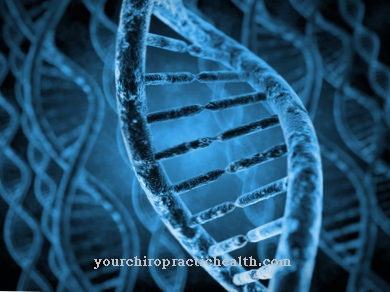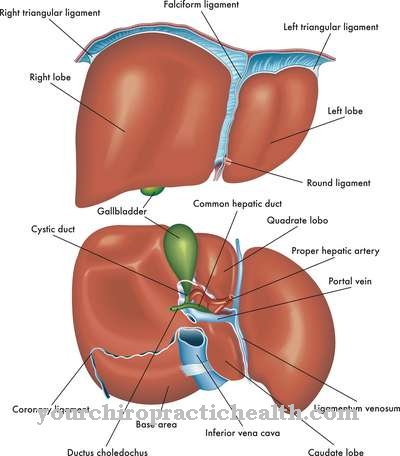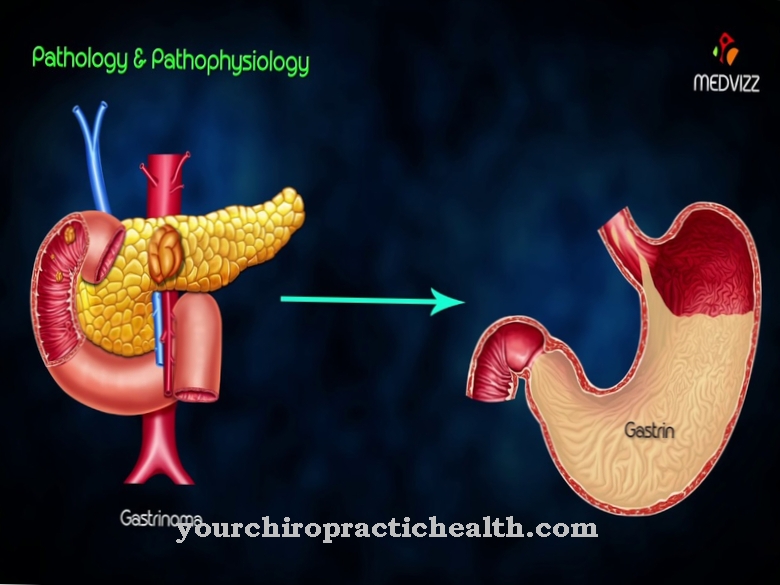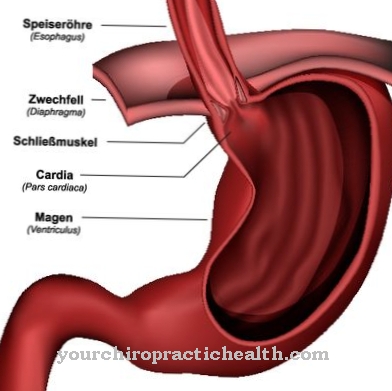Tauopathies represent a group of neurodegenerative diseases which are caused by the deposition of tau proteins in the brain. Alzheimer's disease is the best known tauopathy. So far, these degenerative diseases are not curable.
What is tauopathy?

© artfocus - stock.adobe.com
Tauopathy is a collective term for several neurodegenerative diseases, all of which are associated with the development of dementia. All tauopathies are caused by the build up of tau proteins in the brain. Tau proteins are named after the Greek letter tau.
They bind to the proteins of the cytoskeleton and thus perform supporting functions in animal and human cells. Normally, the tau proteins link with each other via repetitive sections and thus form filamentary structures in the cell. When linking, the amino-terminal end of the polypeptide chain is cut off by phosphorylation.
However, if hyperphosphorylation (saturation of all binding sites with phosphate groups) takes place, a no longer functional protein arises, which cannot build up a bond to the proteins of the cytoskeleton. The protein is deposited in the brain. Hyperphosphorylation is favored by certain mutations.
Six different isoforms are known for the tau protein, which can produce several forms of tauopathy with appropriate genetic changes. Depending on the isoform, a tau protein can contain between 352 and 757 amino acids. The deposition of hyperphosphorylized tau proteins in the brain can develop, among other things, Alzheimer's disease, chronic traumatic encephalopathy (CTE or dementia pugilistica).
Frontotemporal dementia (Pick's disease), corticobasal degeneration, neurofibrillary tangle dementia, progressive supranuclear palsy or silver grain disease are also known to be secondary diseases. For all tauopathies there are no cure prospects yet.
causes
The cause of the tauopathies is the deposition of tau proteins in the brain. At the points in the brain where these ever-increasing deposits are located, there are functional restrictions that ultimately lead to the death of nerve cells and glial cells. This causes the brain to shrink.
It can shrink by up to 20 percent in the context of Alzheimer's disease. In the course of time, important structures of the brain are lost. As a rule, this process is very slow, with tauopathy leading to death on average eight years from the onset.
The basis of the deposits of tau proteins is their inability, due to hyperphosphorylation, to build up sufficient bonds to the proteins of the cytoskeleton. Hyperphosphorylation can be caused by mutations. Around 60 different mutations of the tau gene were discovered, all of which lead to tauopathy.
Hyperphosphorylation is actually a normal process that serves as a signaling mechanism to trigger cell division. Due to certain mutations, however, the hyperphosphorylation is intensified and, among other things, generates waste products of the tau protein, which are no longer capable of binding and therefore have no function. However, one form of tauopathy, chronic traumatic encephalopathy, is not genetic, but is caused by frequent head injuries.
Here, too, hyperphosphorylation of tau proteins occurs. The phosphorylation is possibly triggered here by regulatory processes. After injuries, cell division must be stimulated in order to heal. However, this is stimulated by the signaling effect of phosphorylation.
Symptoms, ailments & signs
The main symptom of tauopathy is the development of dementia. This applies to all forms of tauopathies. The best-known example of this group of diseases is Alzheimer's disease. The term Alzheimer's is often equated with dementia. However, this is not correct. Dementia is just the main symptom of this condition.
All other diseases in this group of forms also develop dementia as the most important symptom. Alzheimer's disease begins insidiously with general forgetfulness. At a further stage, the patient loses the simplest practical skills, such as dressing or making coffee. In the last stage, patients suffer from apathy, loss of appetite, bed restraint and incontinence. He can no longer recognize people close to him.
Another disease is corticobasal degeneration (CBD). In this disease, symptoms similar to those of Parkinson's occur in addition to dementia. This leads to tremors, depression, anxiety, immobility, gait disorders and eye movement disorders.
In Pick's disease, behavioral problems and impaired performance are in the foreground. Here, too, progressive dementia develops. Progressive supranuclear palsy is characterized by the failure of the eye muscles and a Parkinson-like clinical picture. A special form of Alzheimer's disease is suspected of being silver grain disease.
Chronic traumatic encephalopathy is a tauopathy that is caused by external influences such as head injuries. Martial artists and boxers, in particular, are at risk of suffering from this disease in their later years. This illness begins with a headache and difficulty concentrating.
In the further course, a disturbed short-term memory, depression and emotional outbursts are added. In a final stage, the patient suffers from pronounced dementia, which makes it impossible for him to cope with everyday life.
Diagnosis & course of disease
The diagnosis of tauopathies is based on personal and external medical history. In addition, several neuropsychological tests such as the watch test or the mini mental status test (MMST) are carried out. Imaging procedures such as CT and MRI are also part of the diagnosis. The symptoms that occur give clues to the type of tauopathy.
Complications
Unfortunately, the tauopathy cannot be completely cured, so there is no completely positive course in this disease. Those affected suffer from different complaints. This leads to loss of appetite and incontinence. Internal restlessness or confusion can also occur and have a very negative effect on the patient's everyday life.
Many patients then depend on the help of other people in their lives and can no longer do many things in everyday life on their own. Depression or tremor also occur in tauopathy. Most patients also suffer from behavioral problems and gait disorders. A loss of coordination can also occur.
Because of the confusion, the risk of injury increases enormously, so that those affected can also lose consciousness. Patients also often suffer from headaches or from concentration disorders. The symptoms of tauopathy can be limited with the help of medication.
There are no complications. However, complete cure cannot be achieved. Whether this disease will lead to a reduced life expectancy for the patient cannot generally be predicted.
When should you go to the doctor?

A doctor should be consulted for tauopathy if the person affected suffers from severe loss of appetite and incontinence. In many cases, depression or difficulty moving occurs. Many also show abnormal behavior in tauopathy, which should also be checked by a doctor. Severe concentration problems or severe headaches can also indicate this disease. First and foremost, tauopathy can be detected by a general practitioner or a pediatrician. Further treatment depends on the exact symptoms and is carried out by a specialist.
Treatment & Therapy
Tauopathies cannot yet be treated causally. In the context of Alzheimer's disease, various drugs are administered that are supposed to improve memory. For the other tauopathies, too, symptomatic treatment methods are used to improve the symptoms and delay the course of the disease.
You can find your medication here
➔ Medicines against memory disorders and forgetfulnessprevention
Although most tauopathies are genetic, a healthy lifestyle and constant mental exercise can help delay the onset and progress of the disease.
Aftercare
Taupathy is incurable and affects the life expectancy of those affected. Follow-up care for this disease is therefore only possible to a limited extent. Early detection is of great importance for the further course. The taking and dosage of medication as well as the course of the disease should be monitored by the treating doctor.
Possible side effects of the medication as well as new symptoms can be treated more quickly. Patients are more likely to develop pneumonia. This can be counteracted by taking precautions to maintain lung health, such as regular flu vaccinations. Since there are physical impairments, care assistance is required in everyday life.
Sometimes the patients also need a wheelchair. Physiotherapy can also improve or slow down the impairment of movement. If possible, sporting activities in leisure time are positive for body and mind. The type of sport and intensity should be clarified with a doctor beforehand.
The physical impairments usually also lead to psychological problems such as depression. Psychological counseling and involvement in family life are important for those affected. Friends also play a major role so that the patient is not alone with his situation and can cope better with it.
You can do that yourself
Tauopathies cannot yet be treated causally. It is best for those affected to contact a neurologist so that they can take appropriate action. Symptomatic treatment should be done in collaboration with a specialist.
Medical treatment is necessary if symptoms such as loss of appetite or bed restraint are present. Those affected are usually so seriously ill that they can no longer act independently. This makes it all the more important to get help from relatives, who must ensure that the medication is taken according to the instructions and that the patient does not show any other symptoms. In order to avoid sores when bedridden, the sick person must regularly change position or be brought into another position. In addition, various ointments from homeopathy can be used.
Close people often also need therapeutic support themselves. Especially in the last stage of the disease, those affected can usually no longer recognize their acquaintances, which is an enormous emotional burden for them. Since most tauopathies are genetic, prevention is also not possible. However, a healthy lifestyle and regular mental training can delay the disease. Which measures are useful and necessary in detail is best discussed with the responsible specialist.



























